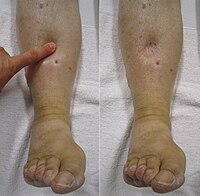
Photo from wikipedia
Summary Background While fluid flows in a steady state from plasma, through interstitium, and into the lymph compartment, altered fluid distribution and oedema can result from abnormal Starling's forces, increased… Click to show full abstract
Summary Background While fluid flows in a steady state from plasma, through interstitium, and into the lymph compartment, altered fluid distribution and oedema can result from abnormal Starling's forces, increased endothelial permeability or impaired lymphatic drainage. The mechanism of oedema formation, especially the primary role of hypoalbuminaemia, remains controversial. Here, we explored the roles of albumin and albumin-independent mechanisms in oedema formation among children with severe malnutrition (SM). Methods We performed secondary analysis of data obtained from two independent clinical trials in Malawi and Kenya (NCT02246296 and NCT00934492). We then used an unconventional strategy of comparing children with kwashiorkor and marasmus by matching (discovery cohort, n = 144) and normalising (validation cohort, n = 98, 2 time points) for serum albumin. Untargeted proteomics was used in the discovery cohort to determine plausible albumin-independent mechanisms associated with oedema, which was validated using enzyme-linked immunosorbent assay and multiplex assays in the validation cohort. Findings We demonstrated that low serum albumin is necessary but not sufficient to develop oedema in SM. We further found that markers of extracellular matrix (ECM) degradation rather than markers of EG degradation distinguished oedematous and non-oedematous children with SM. Interpretation Our results show that oedema formation has both albumin-dependent and independent mechanisms. ECM integrity appears to have a greater role in oedema formation than EG shedding in SM. Funding Research Foundation Flanders (FWO), Thrasher Foundation (15122 and 9403), VLIR-UOS-Ghent University Global Minds Fund, Bill & Melinda Gates Foundation (OPP1131320), MRC/DfID/Wellcome Trust Global Health Trials Scheme (MR/M007367/1), Canadian Institutes of Health Research (156307), Wellcome Trust (WT083579MA).
Journal Title: EBioMedicine
Year Published: 2022
Link to full text (if available)
Share on Social Media: Sign Up to like & get
recommendations!